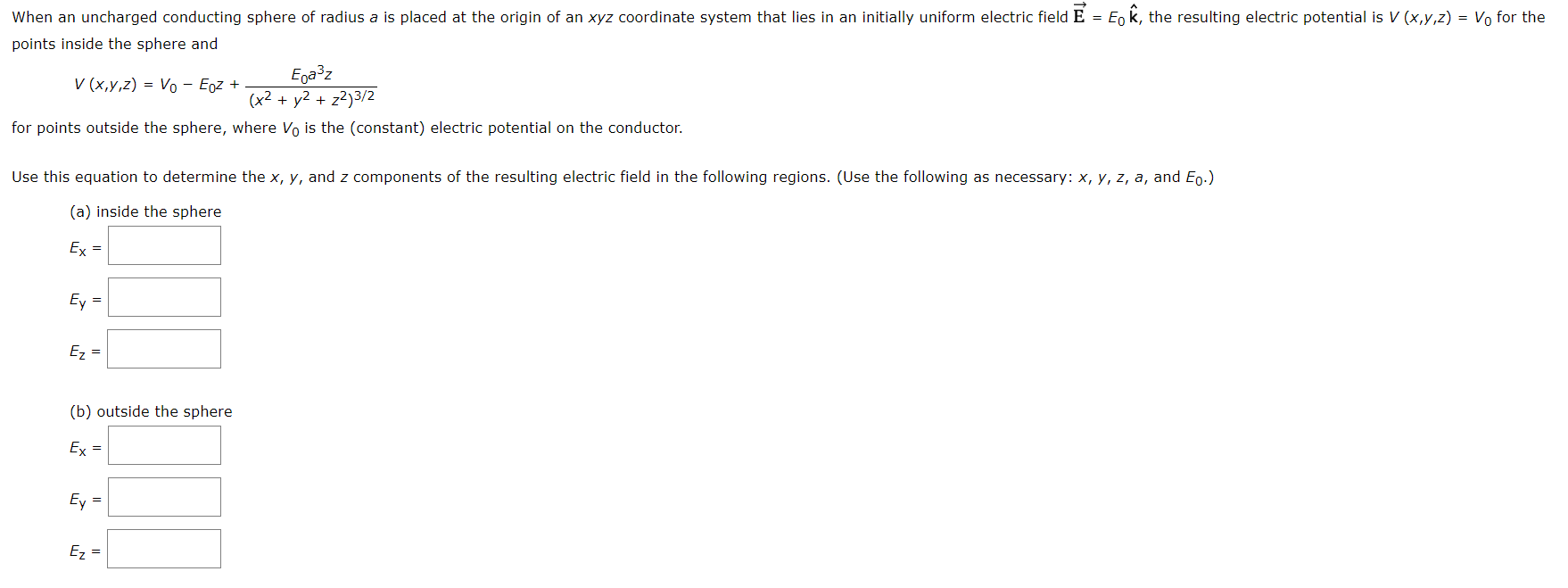Eo k, the resulting electric potential is V (x,y,z) = Vo for the When an uncharged conducting sphere of radius a is placed at the origin of an xyz coordinate system that lies in an initially uniform electric field E points inside the sphere and Eoа3z (x2y223/2 V (x,y,z) Vo - Eoz for points outside the sphere, where Vo is the (constant) electric potential on the conductor. Use this equation to determine the x, y, and z components of the resulting electric field in the following regions. (Use the following as necessary: x, y, z, a, and Eo.) (a) inside the sphere Ex = Ey = Ez (b) outside the sphere Ex Ey = Ez =
Eo k, the resulting electric potential is V (x,y,z) = Vo for the When an uncharged conducting sphere of radius a is placed at the origin of an xyz coordinate system that lies in an initially uniform electric field E points inside the sphere and Eoа3z (x2y223/2 V (x,y,z) Vo - Eoz for points outside the sphere, where Vo is the (constant) electric potential on the conductor. Use this equation to determine the x, y, and z components of the resulting electric field in the following regions. (Use the following as necessary: x, y, z, a, and Eo.) (a) inside the sphere Ex = Ey = Ez (b) outside the sphere Ex Ey = Ez =
Principles of Physics: A Calculus-Based Text
5th Edition
ISBN:9781133104261
Author:Raymond A. Serway, John W. Jewett
Publisher:Raymond A. Serway, John W. Jewett
Chapter20: Electric Potential And Capacitance
Section: Chapter Questions
Problem 22P
Related questions
Question

Transcribed Image Text:Eo k, the resulting electric potential is V (x,y,z) = Vo for the
When an uncharged conducting sphere of radius a is placed at the origin of an xyz coordinate system that lies in an initially uniform electric field E
points inside the sphere and
Eoа3z
(x2y223/2
V (x,y,z) Vo - Eoz
for points outside the sphere, where Vo is the (constant) electric potential on the conductor.
Use this equation to determine the x, y, and z components of the resulting electric field in the following regions. (Use the following as necessary: x, y, z, a, and Eo.)
(a) inside the sphere
Ex =
Ey =
Ez
(b) outside the sphere
Ex
Ey
=
Ez =
Expert Solution
This question has been solved!
Explore an expertly crafted, step-by-step solution for a thorough understanding of key concepts.
This is a popular solution!
Trending now
This is a popular solution!
Step by step
Solved in 6 steps with 6 images

Recommended textbooks for you

Principles of Physics: A Calculus-Based Text
Physics
ISBN:
9781133104261
Author:
Raymond A. Serway, John W. Jewett
Publisher:
Cengage Learning

Physics for Scientists and Engineers: Foundations…
Physics
ISBN:
9781133939146
Author:
Katz, Debora M.
Publisher:
Cengage Learning

Physics for Scientists and Engineers, Technology …
Physics
ISBN:
9781305116399
Author:
Raymond A. Serway, John W. Jewett
Publisher:
Cengage Learning

Principles of Physics: A Calculus-Based Text
Physics
ISBN:
9781133104261
Author:
Raymond A. Serway, John W. Jewett
Publisher:
Cengage Learning

Physics for Scientists and Engineers: Foundations…
Physics
ISBN:
9781133939146
Author:
Katz, Debora M.
Publisher:
Cengage Learning

Physics for Scientists and Engineers, Technology …
Physics
ISBN:
9781305116399
Author:
Raymond A. Serway, John W. Jewett
Publisher:
Cengage Learning


Classical Dynamics of Particles and Systems
Physics
ISBN:
9780534408961
Author:
Stephen T. Thornton, Jerry B. Marion
Publisher:
Cengage Learning